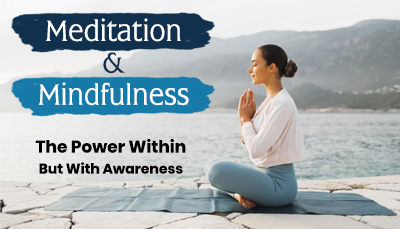
In today’s fast-paced world, meditation and mindfulness have emerged as powerful tools for managing stress, improving mental clarity, and enhancing emotional balance. From office boardrooms to school classrooms, and from hospitals to homes, these ancient practices—once limited to monasteries—are now being embraced globally. But just like any medicine, even meditation needs the right dosage, the correct method, and sometimes professional guidance.
Science now supports what Indian sages have practiced for centuries. Meditation helps reduce anxiety, lowers blood pressure, improves sleep quality, and even sharpens attention and memory.
Students report better focus and emotional stability.
Working professionals experience improved productivity and reduced burnout.
Patients with chronic illnesses feel a sense of inner calm and better pain control.
From Harvard to AIIMS, institutions have documented these benefits. Mindfulness-Based Stress Reduction (MBSR) and Yoga Nidra are being used across the world, including in hospitals and counseling centers.
While meditation is often marketed as a magic pill, studies show that for some people, especially those with a history of anxiety or unresolved trauma, meditation may unearth uncomfortable emotions or even worsen symptoms.
🔍 A study published in Acta Psychiatrica Scandinavica reported that nearly 1 in 10 regular meditators experienced adverse psychological effects such as dissociation, anxiety, or emotional instability lasting more than a month.
These effects are more common when people practice meditation intensively without guidance. The mind is like a mirror—if we polish it too fast, the hidden cracks may suddenly become visible.
India’s rich spiritual heritage has always emphasized that meditation is not merely a technique—it’s a discipline rooted in ethics, moderation, and gradual self-awareness.
The Bhagavad Gita advocates a balanced approach: “Yoga is not for one who eats too much, nor for one who eats too little... it is the path of balance.”
Similarly, Patanjali’s Yoga Sutras highlight ethical precepts (Yama and Niyama) as foundational before entering deep meditation.
Modern adaptations, especially mobile apps or crash courses, often miss this layered structure. This is where guided programs and medical supervision come in.
1. Start Slow – Begin with 10–15 minutes a day; gradually increase based on comfort.
2. Use Guided Tools – Choose credible instructors, apps, or medical programs.
3. Be Watchful – If you feel increased anxiety, emotional upheaval, or detachment, stop and seek professional help.
4. Avoid in Isolation – Meditation is best supported by physical activity, community, and a healthy lifestyle.
5. Consult a Doctor – Especially if you’re dealing with mental health conditions, chronic illness, or trauma history.
As a surgeon and wellness advocate, I’ve seen how physical healing is deeply connected to mental clarity. At Arogya Hospital, Ludhiana, we encourage a mind-body approach to recovery—combining evidence-based surgery with stress management, counseling, and where appropriate, guided meditation.
Meditation isn’t just sitting with your eyes closed—it’s about opening a conversation with yourself. But like any deep conversation, it must be done gently and with guidance.
Let us make meditation not a trend, but a safe and empowering journey toward health, peace, and inner resilience.
Dr. Ashish Ohri
MBBS, MS, FMAS, FIAGES
Consultant Laparoscopic & Bariatric Surgeon
Arogya Hospital, Jassian Road, Ludhiana

